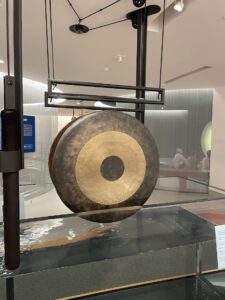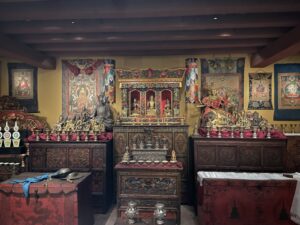I decided to visit the Rubin Museum of Art, accompanied by my sister. As somebody who has had a lifelong interest in cultures other than my own, the idea of seeing an exhibit filled with Tibetan and Himalayan art and culture, which I admittedly do not have much knowledge of outside of a high school world religion class, tantalized me. Another major factor which spurred my visit to the Rubin specifically was the unfortunate fact that it is closing its Chelsea location in favor of becoming a virtual museum. Thus, I made my journey to Manhattan–a rather comfortable one thanks to the humble SIM1C.
As I made my way into the museum and up the stairs to the second floor, I was entranced. Glimmering golden tapestries and ornate copper statues were a visual treat. One of the first pieces I had noticed that truly struck a chord with me, and which dwelled in my mind for the entire duration of my visit to the Rubin, was a tantric copper statue of the Vajradhara Buddha with a consort. As I examined their intertwined bodies, Berger’s discussion of sexuality as depicted in Eastern art as opposed to Western art in Ways of Seeing immediately came to mind. Berger detailed that Eastern art never objectified women as European art did. Instead of being objects of male sexual desire, naked women in Eastern art were depictions of sexual love between two people. I found the depiction of sexual love in this statue refreshing compared to the idea of the female nude so prevalent in the old European canon.

A bit later into my visit, I encountered something I had never seen the likes of at any museum I have ever been to. The Mandala Lab was an interactive exhibition created by contemporary artists which was based on core Buddhist tenets and meant to stimulate all of one’s senses, not just sight. Personally, I found the scent library to be among the most interesting aspects of the Mandala Lab. It involved six different stations where one would press a button and a scent created by master perfumer Christophe Laudamiel would be blown at you. From there, you would choose emotions on a wheel and describe how the scent made you feel. Each of the six scents were created in collaboration with artists who connected them back to a specific time of their life. They ranged from cigarette smoke and the smell of the earth after rain–two scents which, unfortunately for me, aggravated a migraine–to temple incense, which I found the most pleasant.
Aside from the olfactory experience, the auditory experience was definitely among my favorites. Designed for the museum-goer to express their anger, it involved a collection of gongs which were designed by various artists in differing size and shape, and therefore sound. The instructions were to think about your anger, strike the gong with the mallet provided, and lower it into a pool of water to see how it altered the sound. To me, it served as a testament to transforming anger into something productive, something beautiful. As I struck the gongs and heard their reverberations alter after being lowered into the water, it made me examine how I can transform my own anger; how I can transfer that negative energy into something positive.

Something else I enjoyed about the Rubin was the Tibetan Buddhist Shrine Room. I have never had the opportunity to go into a house of worship other than my own church, so I highly appreciated having such an opportunity at the Rubin. My initial impression of the Shrine Room was how profoundly beautiful and ornate it was–as a Catholic, I must say that I have quite the penchant for the ornate. The room was dimly lit and the soft smell of incense wafted through the air. To me, it was entrancing. The appliqué tapestries adorning the wall along with dozens of little statues and candle holders almost reminded me of stained glass windows and offering candles in a Catholic church–though I obviously know the two are completely different, it proved to me how universal and innately human the appreciation of beauty in worship is.

(My picture may seem brighter than how I described, but that’s just thanks to my overexposed phone camera.)
One of the last things that I saw at the Rubin was a short film, Yarlung (2020), directed by Kunsang Kyirong, a Toronto-based indie filmmaker. Yarlung follows the story of how three children cope with the death of their mother, and how the Yarlung Tsangpo river allows them to cope and deal with their immense loss. For them, the river is both sacred and a comfort to them in a difficult time: they played, swam, and fished in the river, like the village children generations before them. There was also an ongoing motif of their grandmother’s tea, another comfort to the children. The way they took refuge in nature almost struck me as Romantic, which I appreciated. Visually, the film was beautifully animated in a simple charcoal-drawn style that I found comforting. Tea and the river were intertwined in the film, or it seemed as such to me, as ancient, time-honored comforts to the people of Kyirong’s village. In its five minutes, Yarlung conveyed a powerful message about finding comfort in simplicity and the familiar. Not only were the children able to find peace, but I felt that as a viewer, the environment Kyirong created in the film extended to myself as I was watching–it even made me feel more relaxed. I found that Kyirong was able to deliver such a strong message in five minutes what some renowned directors are unable to do in two hours, and I commend her for that.
The Rubin museum is easily one of the most beautiful museums I’ve ever been to, aesthetically and otherwise. Exposing myself to a culture I knew next to nothing about certainly paid off, as I feel my visit offered me some insight into Tibetan culture. Although it is an absolute travesty that the physical building will be closing, I left the Rubin with a strong desire to learn more about Himalayan art and culture and will definitely make an effort to do so.


